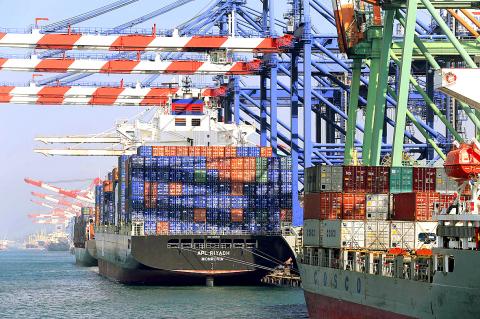The value of export orders dropped 5.9 percent annually and 4.1 percent monthly to US$35.79 billion last month, dragged down mainly by declining orders from China and Hong Kong, the Ministry of Economic Affairs said yesterday.
The value of orders from China and Hong Kong fell by US$1.17 billion from a year earlier to US$8.98 billion last month, accounting for 52.7 percent of the US$2.22 billion annual drop in overall export orders last month, the ministry said.
“The increasing localization of supply chains in China is an issue that we have to face seriously,” Department of Statistics Director-General Lin Lee-jen (林麗貞) told a news conference in Taipei, adding that last month’s data on orders from China and Hong Kong marked the fifth consecutive month of decline, excluding Lunar New Year holiday factors.

Photo: CNA
Weaker-than-expected growth in China has also affected demand for Taiwanese goods, Lin said. She said it would be worth observing if the annual decline in export orders from China and Hong Kong would extend throughout the year, citing the faster-than-expected rise of supply chains in China.
“Aside from flat panels, we noticed that Taiwan’s integrated circuit design, packaging and testing service sectors have also been facing increasing challenges in China,” Lin said.
In addition, the weak demand for PCs in Europe and handheld devices in emerging markets also affected the performance of the nation’s electronics and precision instruments industries, Lin said.
Apart from the information and communication technology industry, which saw a 2.3 percent annual increase in orders to US$9.7 billion, the ministry’s report showed broad declines in orders for electronics, precision instruments, basic metals, petrochemicals and machinery products last month from the same period a year ago.
By country, the US was still Taiwan’s largest export destination, with orders increasing 5.2 percent to US$9.79 billion from the same period a year ago, Lin said.
However, the annual growth rate for US orders was slower than the 14 percent registered a month earlier, an indicator of weakening demand as the product cycle for Apple Inc’s iPhone nears a refresh, Lin said.
Orders from China and Hong Kong, Europe, ASEAN and Japan all saw an annual decline last month, with orders from China and Hong Kong and Japan plunging by double-digit percentage points from a year ago, Lin said.
Lin said the ministry forecasts the value of this month’s export orders to be flat or decline from last month’s US$35.79 billion. As such, the value of export orders this month will likely decline from last year’s US$38.82 billion, she said.
The value of export orders totaled US$180.47 billion in the first five months of this year, 0.6 percent less than in the same period last year, the ministry’s data showed.
The total value for the first half of this year is expected to be less than the US$220.47 billion in the same period last year, Lin said.
However, Lin said the ministry remains optimistic on export orders in the second half of this year, citing the upcoming launches of Microsoft Corp’s Windows 10 operating system and new Apple products.

LIMITS: While China increases military pressure on Taiwan and expands its use of cognitive warfare, it is unwilling to target tech supply chains, the report said US and Taiwan military officials have warned that the Chinese People’s Liberation Army (PLA) could implement a blockade within “a matter of hours” and need only “minimal conversion time” prior to an attack on Taiwan, a report released on Tuesday by the US Senate’s China Economic and Security Review Commission said. “While there is no indication that China is planning an imminent attack, the United States and its allies and partners can no longer assume that a Taiwan contingency is a distant possibility for which they would have ample time to prepare,” it said. The commission made the comments in its annual

DETERMINATION: Beijing’s actions toward Tokyo have drawn international attention, but would likely bolster regional coordination and defense networks, the report said Japanese Prime Minister Sanae Takaichi’s administration is likely to prioritize security reforms and deterrence in the face of recent “hybrid” threats from China, the National Security Bureau (NSB) said. The bureau made the assessment in a written report to the Legislative Yuan ahead of an oral report and questions-and-answers session at the legislature’s Foreign Affairs and National Defense Committee tomorrow. The key points of Japan’s security reforms would be to reinforce security cooperation with the US, including enhancing defense deployment in the first island chain, pushing forward the integrated command and operations of the Japan Self-Defense Forces and US Forces Japan, as

‘TROUBLEMAKER’: Most countries believe that it is China — rather than Taiwan — that is undermining regional peace and stability with its coercive tactics, the president said China should restrain itself and refrain from being a troublemaker that sabotages peace and stability in the Indo-Pacific region, President William Lai (賴清德) said yesterday. Lai made the remarks after China Coast Guard vessels sailed into disputed waters off the Senkaku Islands — known as the Diaoyutai Islands (釣魚台) in Taiwan — following a remark Japanese Prime Minister Sanae Takaichi made regarding Taiwan. Takaichi during a parliamentary session on Nov. 7 said that a “Taiwan contingency” involving a Chinese naval blockade could qualify as a “survival-threatening situation” for Japan, and trigger Tokyo’s deployment of its military for defense. Asked about the escalating tensions

The Ministry of Economic Affairs said it plans to revise the export control list for strategic high-tech products by adding 18 items under three categories — advanced 3D printing equipment, advanced semiconductor equipment and quantum computers — which would require local manufacturers to obtain licenses for their export. The ministry’s announcement yesterday came as the International Trade Administration issued a 60-day preview period for planned revisions to the Export Control List for Dual Use Items and Technology (軍商兩用貨品及技術出口管制清單) and the Common Military List (一般軍用貨品清單), which fall under regulations governing export destinations for strategic high-tech commodities and specific strategic high-tech commodities. The